
With a small but passionate maker of sporty cars and oddball engines taking center stage at this year’s Goodwood Festival of Speed, all manner of Hiroshima steel could be found on the show grounds. A seemingly mundane Mazda RX-7 looked like any number of cars you might see at a weekend SCCA race, but this little rotary actually has huge, huge provenance. This very car, back in 1981, outright won the 24 Hours of Spa-Francorchamps, Europe’s other backbreaking endurance race.

The story of the Mazda RX-7’s astounding success as an endurance racer begins in 1979, when an SA22 driven by Yojiro Terada, Yoshimi Katayama, and Takashi Yorino won its class at the 24 Hours of Daytona. While an impressive feat for the RX-7’s inaugural race, what was perhaps even more unexpected was that the car came in fifth overall, ahead of a field of Porsche 911 RSRs, BMW 3.5 CSLs, and Detroit V8s.

Seeking to achieve similar success in Europe, Mazdaspeed looked towards Europe and an assault on the grueling 24 Hours of Spa. Around that time, a Belgian importer of Mazdas named Jacques Beherman and his PR man were interested in getting the RX-7 into racing. They were introduced to Tom Walkinshaw, a noted British driver who had founded his own race car engineering firm, by another Belgian racer named Bernard de Dryver (pretty awesome name considering his profession). Tom Walkinshaw Racing, or TWR, had begun tinkering with the SA22 early on, even before they went on sale in the UK, for competition in the British Sports Car Championships (which became BTCC). It was a perfect match, and soon the group had secured Motul Oil as the main sponsor.
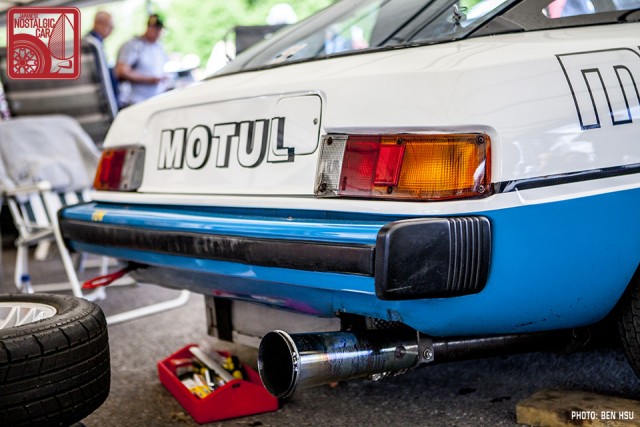
TWR fielded four cars at Spa in 1980, 11 years after Mazda had almost won there with the Familia Rotary Coupe (known in the US as the R100). Walkinshaw recruited Daytona winner Yojiro Terada, Win Percy, and Peter Lovett as drivers, among others (Percy and Lovett were already driving for TWR in BTCC).
The standard RX-7 engine was modified to put out 225hp at 9000rpm, nearly twice the power of the street cars. However, despite having a 2 x 573cc dual-rotor 12A, officials classified it as equivalent to a 2.3L piston engine, placing it with some stiff competition in the 2.5L class. Nobody thought it had a chance to win, especially since the rest of the field was comprised mostly of 3.0L Capris, 530i BMWs and V8 Camaros.
Alas, in this debut year the Mazdas finished with unremarkable results. Terada’s car logged a DNF, the Percy-Lovett car lost a wheel close to finishing, and the two remaining cars finished 21st and 22nd overall (4th and 5th in their class).
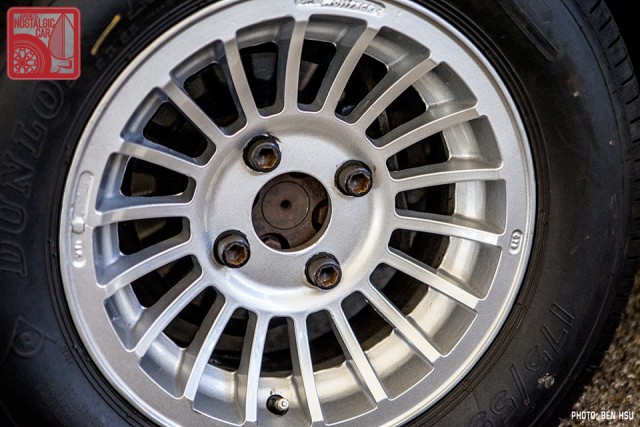
Driving one of the BMWs that year was Belgian Pierre Dieudonné, a name you may recognize as one of the drivers that took the legendary Mazda 787B across the finish line at Le Mans in 1991. TWR recruited him, first for a UK race, then for the Belgian Circuits Championships, in which the team of TWR-Motul-those Belgian importer guys, desperately wanted to score a win.
However, the allure of Spa always loomed overhead. Walkinshaw was a pretty colorful character, and while the 1981 24 Hours of Spa wasn’t actually part of that championship, they entered it anyway more or less for publicity and giggles. Nevertheless, it was a very prestigious endurance race, especially for touring cars, and Walkinshaw pulled no punches in their approach.
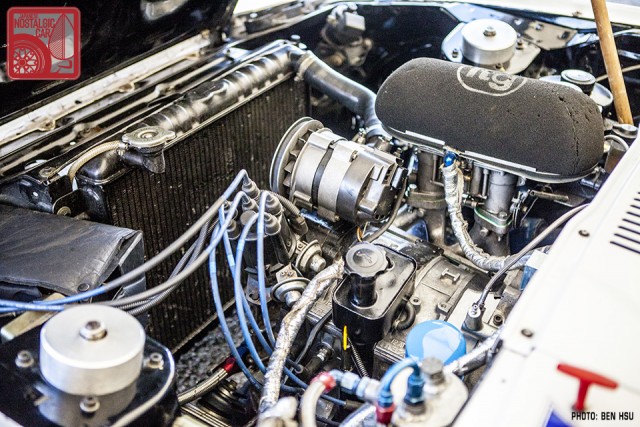
Though Terada didn’t come back to drive in ’81, he was instrumental in the evolution of the car from the previous year. Upon returning to Japan after the 1980 Spa 24, he identified the weak points of the engine and pushed Mazda to homologate parts to modify and improve it. Mazdaspeed (still independent then but partially owned by Terada) sent over three new endurance-spec engines, the 12B, now putting out 235-240hp for use with with Weber 48 IDA downdraft carbs.
With those three motors, TWR built three RX-7s. Walkinshaw was so determined, he invested a ton of resources into the cars. Each was outfitted with specially made Dunlops, rear drum brakes converted to discs, and even built-in hydraulic jacks to speed up tire changes.

Again, nobody thought they had a chance at winning. When Walkinshaw selected Dieudonné to be his driving partner, he gave the Belgian the following instructions: “Our car will be the hare. We’ll go flat out; it’s win or bust!” Flying in the face of typical 24-hour enduro strategy, he explained, “I’m not interested in racing and holding something in reserve just to see the finish.”
As a result, they surprised everyone by qualifying in front of all the BMWs. After terrible rain in the beginning, conditions turned clear for the 1st half of the race as the Mazdas moved up consistently. The car proved light and responsive, thanks to the rotary’s compactness and front-midship layout. It was reportedly very easy to drive, which helped keep driver fatigue at bay as the hours wore on.
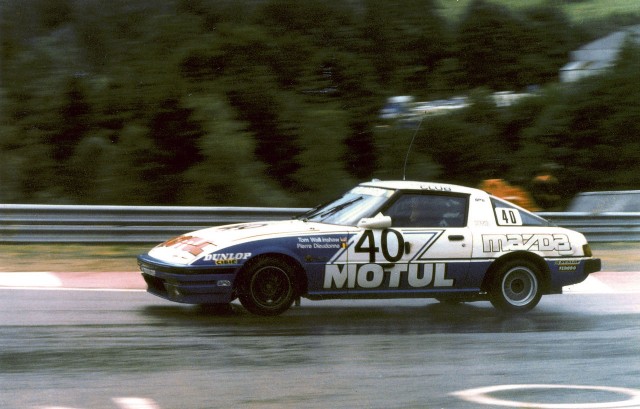
As day broke the Walkinshaw-Dieudonné #40 car was running second. Only the Juma BMW, which Dieudonné had driven in 1980, was in front. Walkinshaw was driving at the time, and pushed the BMW hard. It was a surprise to everyone, and at this point the TV cameras began to pay attention to the RX-7s.
The next driver change would be the last of the race. As Walkinshaw stepped out of the car he told Dieudonné, “Go flat out — 9000 rpm — and push like crazy. It’s our only chance of breaking that bloody BMW!” By mid-morning the RX-7 had snatched the lead, forcing the Juma BMW drivers to go all out as well. And, true to Walkinshaw’s plan, they broke the bloody BMW! A damaged rocker arm killed its valvetrain — something the rotaries never had to worry about — 90 minutes before race’s end, giving the win to the RX-7.
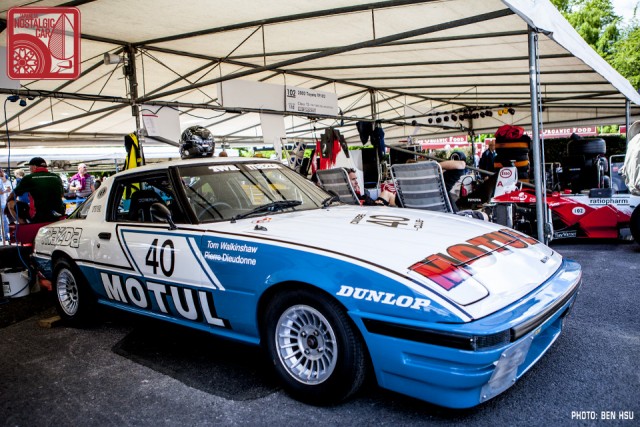
Out of 55 cars on the starting grid, only 26 finished. The victory marked the first win at the 24 Hours of Spa by a Japanese car. And, because the #42 RX-7 took 5th place, the TWR-Mazdaspeed-Motul team also won the Coupe du Roi (King’s Cup) that year (incidentally, two E70 Corolla coupes also ran the race. One actually finished decently — 17th overall, 1st in its class). TWR also went on to win the Belgian Productions Car Championship title for 1981.
Of course, Tom Walkinshaw Racing is probably most well known for his Silk Cut Jaguar XJR-9 Le Mans cars, after racing for Jaguar starting in 1982. As fate would have it, ten years later Dieudonné, the driver Walkinshaw had recruited from BMW, would drive for Mazdaspeed against his own TWR Jags at Le Mans… and beat them.
Though this story is not very well-known in the US, it was likely quite heavily advertised in Japan at the time, and rightly so. It would explain why the TWR bumper was so popular there. It was even offered as a dealer accessory in Europe and Japan on facelifted RX-7s. The TWR RX-7 really should be placed on the same pedestal as the Daytona RX-7 and the Le Mans 787B, forming a trio of endurance racing champions. Apparently we aren’t the only ones that think it’s earned a special place in history — check out Evo’s excellent driving video of the car below.






I remember the poster that Mazda must have produced, touting this fantastic SPA24 victory. As the 19-year-old owner of a brand new 1981 RX-7 GSL, it was a proud moment as I became entrenched in the world of motorsport! Great memories!
Did you see that poster in the US? Back then, Mazda made an ad/poster in Japan of their ’81 endurance racers: the TWR car, the type 253 (RX-7-based) ran by JUN at Le Mans, and one of the Daytona cars.
I did a tour of Europe that summer, starting with Lemans, down to Jarama, over to Brands Hatch then Silverstone and Snetterton. Crossed the channel to Spa and finished in Hockenheim. Magic. Caught a ride from the campsite to the circuit with the TWR team.
Yes.
The RX-7 was very busy blowing minds. Way cooler than most people know.
Thanks for sharing, Dave. Is there any Japanese automaker more adept at 24 hour endurance races than Mazda?
=P
The rotary engine really gives them the
unfair advantagecompetitive edge in endurance racing!What a great article! Nice job, Dave!
One of my early autocross experiences back in the 80’s was in an SA22, an early 12A car. What a fun little beastie that was, so different from the ’66 Corvair that preceded it. Seeing and hearing one in race guise now stirs up some great memories.
Thanks!!
Their sound really stirs up something. I feel many people got hooked initially by hearing them on a race track.
“Our car will be the hare. We’ll go flat out; it’s win or bust!”
Same strategy the IMSA GTO RX-7s used at Daytona and Sebring. Even with the 13B they were down 300hp from the V8s, but while the V8s would hold back during an endurance event, the rotaries would go flat out to the finish. If there were no prototypes like at Spa 24, the 7 would’ve taken an overall win at Daytona too.
Good point!
car porn!
Thanks for sharing. Was not familiar with this car. I had to read “won 24hrs Spa outright” a few times to ensure it wasn’t a typo. Another notch on my “proud rx7 owner” belt.
What size rims are on this car? 175/55R ??
Seems like 14’s but I cannot tell for sure. They’re tiny. 175s~
Based on the HP ratings listed, I am assuming the Original SPA 1980/81 TWR racing Mazda Rx-7’s were Bridgeported 12A/B’s, but can anyone actual confirm that. As the recent car seen at Goodwood is definitely a Bridge ported engine listening to the exhaust note.